This GSEB Class 8 Maths Notes Chapter 3 Understanding Quadrilaterals covers all the important topics and concepts as mentioned in the chapter.
Understanding Quadrilaterals Class 8 GSEB Notes
→ Paper is an example of plane figure.
→ A plane figure formed by joining number of points without lifting pencil from the paper and without retracing any portion of the drawing other than single points is called a curve.
→ A curve which cuts itself is called a closed curve.
→ A simple closed curve made up of only line segments is called a polygon, e.g., triangle, rhombus, pentagon, hexagon, etc.
→ Convex polygons have no portion of their diagonals in their exteriors. This is not the case with concave polygons.
→ All the sides of a regular polygon have equal lengths, i.e., they are equilateral and equiangular.
→ Angle sum property: The sum of angles of a quadrilateral is 360°.
→ Diagonal is a line segment connecting two non-consecutive vertices of a polygon.
→ Number of diagonals in a polygon of n sides = \(\frac{n(n-3)}{2}\)
→ Sum of all exterior angles of a polygon = 360°.
Kinds of Quadrilaterals:
1. Trapezium:
A quadrilateral having a pair of parallel sides is called a trapezium. Here, ABCD is a trapezium
In which \(\overline{\mathrm{AB}}\) ∥ \(\overline{\mathrm{CD}}\)
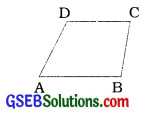
2. Kite: A kite is a quadrilateral having two distinct consecutive pairs of sides of equal lengths. ABCD is a kite having AD = DC and AB=BC.
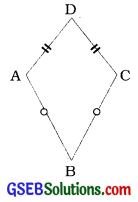
3. Parallelogram:
A quadrilateral having its opposite sides parallel Is called a parallelogram.
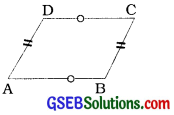
In this figure ABCD is a parallelogram such that AB = CD and \(\overline{\mathrm{AB}}\) ∥ \(\overline{\mathrm{CD}}\)
AD=BC and \(\overline{\mathrm{AD}}\) ∥ \(\overline{\mathrm{BC}}\)
![]()
Properties of parallelogram:
- The opposite sides of a parallelogram are parallel.
- The opposite sides of a parallelogram are equal.
- The opposite angles of a parallelogram are equal.
- The adjacent angles of a parallelogram are supplementary.
- The diagonals of a parallelogram bisect each other.
| Some Special Parallelogram | Properties |
| Rhombus: A parallelogram with all the sides of equal length. 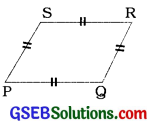 |
1. Al the properties of a parallelogram. 2. DIagonals are perpendicular bisectors of each other. |
| Rectangle: A parallelogram with all the right angles. 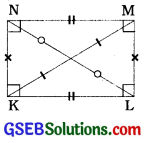 |
1 All the properties of a parallelogram. 2. Each of the angles is a right angle. 3. DIagonals are equal. |
| Square: A rectangle with all the sides of equal length. 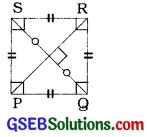 |
1. All the properties of a parallelogram. rhombus and a rectangle. 2. Each diagonal bisects the angle of the square. |
| Kite: A quadrilateral with exactly two pairs of equal consecutive sides. 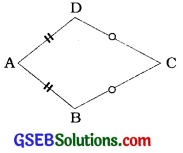 |
1. The diagonals are perpendicular to each other. 2. One of the diagonals bisects the other. 3. In the figure m∠B=m∠D but m∠A ≠ m∠C. i.e., only one pair of opposite angles is equal. |